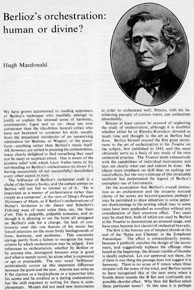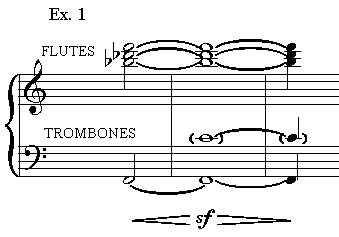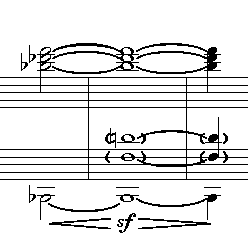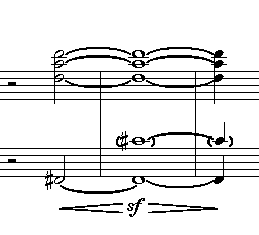
Berlioz’s orchestration: human or divine?
by
Hugh Macdonald
© 1969-2012 Hugh Macdonald

 |
Berlioz’s orchestration: human or divine?by Hugh Macdonald © 1969-2012 Hugh Macdonald |
 |
We have grown accustomed to reading appraisers of Berlioz’s technique who manfully attempt to justify or explain his unusual sense of harmony, counterpoint, fugue and so on; these are now commoner than the (doubtless honest) critics who have not hesitated to condemn his style, usually from the prejudiced standpoint of an unswerving admiration for Brahms, or Wagner, or the pianoforte—anything rather than Berlioz’s music itself. All, however, are united in praising his orchestration, many clearly delighted to find something they need not be nasty or sceptical about. One is aware of the positive relief with which Léon Vallas turns to his sub-heading on Berlioz’s orchestration (in Grove V), having successively (if not successfully) demolished every other aspect in turn.
The brilliance of Berlioz’s orchestral craft is a cliché of the history-books, and the curtest entries on Berlioz will not fail to remind us of it. ‘He is important as a master of orchestration rather than simply as a composer’, is the view of Illing’s Penguin Dictionary of Music, as if Berlioz’s orchestrations of Weber’s Invitation to the Dance and Schubert’s Erlkönig were of more value than, say, the Nuits d’été. This is palpable, pulpable nonsense, and although it is pleasing to see the hosts all arraigned on Berlioz’s side for a change, the lack of controversy over this one feature of his music has forced attention on the more lively battlegrounds of form, harmony, and aesthetics. This unanimity springs partly from a failure to recognize the many criteria by which orchestration may be judged. Few references to orchestration, whether by Berlioz or by anyone else, distinguish between what is good and what is merely novel, let alone what is expressive or apt or practicable. The very word ‘brilliance’ ambivalently covers up this important difference between the good and the new. Anyone can write an F flat clarinet or a hecklephone or a typewriter into his scores and be credited as a daring orchestrator, but the skill required in writing for them is complementary. Mozart did not need new instruments in order to orchestrate well; Strauss, with his bewildering panoply of curious wares, can orchestrate abominably.
Strauss at least cannot be accused of neglecting the study of orchestration, although it is doubtful whether either he or Rimsky-Korsakov devoted as much time and thought to the art as Berlioz had done. Berlioz himself erected the first great monument to the art of orchestration in his Treatise on the subject, first published in 1843, and this must obviously serve as a basis of any study of his own orchestral practice. The Treatise deals exhaustively with the capabilities of individual instruments and lays out clearly what can and cannot be done. He places more emphasis on skill than on seeking out novel effects, but the very existence of this invaluable textbook has perpetuated the legend of Berlioz’s exemplary use of instruments.
On the assumption that Berlioz’s overall distinction as an orchestrator and the uncanny textural clarity of his scores are beyond question, perhaps I may be permitted to draw attention to some apparent shortcomings in his scoring which may in some cases have been applauded as novelties without any consideration of their sonorous effect. Two cases may be cited first, both of which are used by Berlioz in his Treatise to demonstrate an unusual usage, and have since become loci classici of orchestral bravado.
The first is the famous use of timpani chords at the end of the ‘Scène aux Champs’ in the Symphonie Fantastique. The effect is extraordinarily poetic, because it perfectly matches the design of the movement, and suggestively replaces the offstage oboe heard at the beginning; the distant rumble of thunder is ideally captured. Let our approval rest there, for if there is one thing the passage does not suggest it is harmony. There is no sense of F minor when three timpani roll the notes of the triad, and Berlioz seems to have recognized this at the next entry when a fourth drum sounds the B flat and confounds any possible chordal effect. Why then did Berlioz select these particular notes? In this case it is perhaps more the analysts’ ears that have been beguiled, with too much talk of ‘chords’, than Berlioz’s. For the really skilful use of four timpani of different pitches we must look to the ‘Marche au Supplice’ that follows, rather than to the ‘bruit éloigné du tonnerre’.
The second is the celebrated use of trombone pedal notes in the Hostias of the Grande Messe des Morts. This is unquestionably a stroke of inspiration, an effect of cavernous immensity entirely in keeping with Berlioz’s total conception of the work. Some writers praise the effect unreservedly, others (for example Gordon Jacob) consider it horrible. The acoustical truth is that the root position major chords sound infinitely better than the others, for the overtones of eight low trombones are exceedingly strong (both in recording and performance) especially the second harmonic, sounding a 12th above. There are eight chords in the Hostias where the three flutes define a triad, of which only three are root position major chords, the rest are all susceptible to various degrees of distortion by overtones. As each chord approaches its sforzando the overtones emerge and cloud the colour of the harmony; the effect is somewhat as in ex 1. At the end of the movement the passage where the trombones venture below low B flat step by step, reach G sharp and cautiously return to B flat, like a bather who has dipped a toe or two into the water and decided not to plunge, surely smacks more strongly of experimentation than of the raising of the Host. The passage is reproduced in the Treatise, and to these pages it should properly have been confined.



The Grande Messe des Morts also supplies us with a classic case of miscalculation, the sort of thing one finds frequently in the symphonies of Beethoven and Schubert, but which raises a surprised eyebrow in Berlioz. The Requiem is a work of strong, even stark contrasts, one of which is the juxtaposition of the tenor soloist’s serene Sanctus and the chorus’s vigorous fugal Hosanna. The reprise of the Hosanna is glossed by the first violins, muted and divided into four parts, maintaining the ethereal, long, slow chords of the Sanctus, the one pace and timbre superimposed on the other. Only in recording does it seem possible to make these violins audible over the full forte of the rest of the orchestra and chorus, without asking the first violins to draw rapid bows and produce full tone, thus destroying the character of the notes.
Berlioz’s orchestral balance is in general masterly enough, but it would be interesting to discover whether he ever experienced any qualms about the problems of balance encountered in Harold en Italie, a work which has only enjoyed any reasonable circulation since the advent of the gramophone, and which remains exceedingly rare in the concert hall. Soloist and orchestra are hard to balance in any classical concerto, and in Harold the problem is no easier.
About some of Berlioz’s orchestral habits there is greater latitude for disagreement. I have personally never felt convinced that his fondness for divided cellos and basses in dense, low chords is unerringly successful. The scene of Hector’s ghost in Act 1 of Les Troyens is an exception, for the broad pace and the clarity of the chords make the harmonic progressions distinct and audible. It works less well in the duet between Anna and Narbal later in the opera where the orchestral superstructure is heavier, and seems almost clumsy in the Roi de Thulé ballad in La Damnation de Faust (ex 2).

Berlioz also evinces the belief that a low cornet will blend with trombones as an optional fourth voice. It is true that modern trombones have moved a long way from the tone-quality of Berlioz’s time, but it must nevertheless have been extremely difficult even then to bring off this effect. One very rarely hears a successful blend. Generally it is horrible, and even if it can be done by a special exertion on the part of the players, it was surely no part of Berlioz’s purpose to impose undue difficulties upon his executants; the whole gospel of the Treatise is directed towards the simple and effective use of instruments. The two most notable cases of this treatment are the middle section of Andromache’s mime scene in Les Troyens and Méphistophélès’ air ‘Voici des roses’ in La Damnation de Faust.
We have yet to hear a piccolo execute the octave glissando demanded in the last movement of the Symphonie Fantastique, but other actual impossibilities are rare. In Les Troyens the cor anglais has to change to oboe in the space of a dotted quaver, and there is a five-second change for the clarinettist from B flat to A, which is cutting it very fine. On the other hand, he can show over-concern for making things easier for the performers at the expense of the resulting sound. This most often arises in his choral writing, when he is anxious to keep the voices within their allotted range. The basses are given a lower octave which weighs down the upper line; or certain notes are doubled an octave lower. Conductors who suppress the lower octave doubling of the sopranos’ high A flat at the climax of the fugue subject in the Hosanna of the Requiem do wisely.
There is a passage at the end of the first movement of the Symphonie Fantastique where Berlioz divides both groups of violins and apportions the notes between the two players of each desk (ex 3). It is a clever device and undoubtedly useful for less skilled players. At the same time the fragmentation of the line is not properly disguised and there are many bars where there was no need to weaken the tone. Here we have Berlioz’s practicality overriding his idealism, and in the history of orchestration the passage is a major landmark. The 18th-century conception of orchestral instruments as voices, with a consequent refusal to deceive the ear, gives place to the later basis of orchestration in which instruments may legitimately be used as links in a chain, or as particles with which the complete sound is put together. Berlioz’s purpose here is emphatically not to set up a dialogue between separated lines but to use two voices to give the effect of one. It was as much this conception of orchestration that Berlioz bequeathed to later generations as the revelation of new and untried orchestral sonorities.

There are cases where Berlioz’s instructions are ambiguous or incomplete; these can prove maddening to editors and conductors. Each deserves to be investigated more fully, as I can do no more than draw attention to them here. At first sight, for example, the instruction ‘baguettes d’éponge’, so common a marking in Berlioz’s timpani parts, is perfectly explicit; so is the rarer ‘baguettes de bois’. What happens, though, when nothing is marked? There is no cancelling instruction, and the Treatise seems to hint that timpanists would normally have used ‘baguettes de peau’ unless instructed to take either harder (wood) or softer (sponge) headed sticks. Why, then, did he never appear to cancel these directions? For how long a stretch of music can they be assumed to hold good?
Why, also, if the adoption of valves was such a burning question in the mid-l9th century, did he so carelessly mark a stave ‘cors à pistons’ or ‘cors à cylindres’ in one place and simply ‘cors’ in another? Does the player stick to the valved horn even after a change of crook? The incompleteness of the scores is all the more disconcerting because of the unmarked bouché effects implicit in parts for the natural horn.
And then there is the seemingly trivial question of who plays second bassoon. Berlioz’s usual bassoon complement was four, but there are enough occasions on which he specifies two to leave doubt when simply ‘Bassons’ is marked in the score (in the Royal Hunt and Storm for instance). The second desk of bassoons was in origin a doubling, strengthening desk, not an extension of the series. When they played in four real parts first and second played at one desk, third and fourth at the other: when they play in two parts the first player at each desk takes the upper line (even, it seems, when the part was marked ‘solo’), each second the lower, and when only two players are required ‘les deux premiers bassons’ could mean two things, either the first at each desk or the first desk.
The point is not that it matters much who plays which part (although the possibility that ‘solo’ can imply two players should be observed) but that Berlioz should have left the matter so open to question. Yet he is not entirely to be blamed for our uncertainties because his directions assumed the common knowledge of contemporary orchestral practice. No doubt orchestral players, then as now, knew what was implicit in the notes. For us the difficulty is to reconstruct these assumptions, and this can only be done by a broad and detailed study of the scores and orchestral material of the time.
I do not wish to dwell on Berlioz’s failings as an orchestrator, for to restore a proper balance would require me to table, at incredible length, the felicities and masterstrokes of his scores. I would merely ask that his orchestration be seen as an integral part of his technique, perhaps the most strikingly original part, but not something separate and untouchable. To arrive at a true judgment one must assess critically the novelty, the historical importance, the practicability, the sensory effect, and the expressive effect respectively, without blindly assuming that one is as good as the other. If a centenary may seem a curious moment to debunk what has traditionally been the composer’s highest attribute, I suspect that Berlioz’s rehabilitation has progressed far enough for special pleading to be unnecessary. In any case it is as a composer that his stature at last stands so high, not as a mere sonic manipulator.
![]()
* We are most grateful to Hugh Macdonald for
granting us permission to reproduce this article on this page.
We have transcribed the text of the article from The
Musical Times, March 1969, a copy of which is in our collection. We have not been able to contact the
editor of The Musical Times, which has ceased
publication.![]()
![]()
The Hector Berlioz Website was created by Monir Tayeb and Michel Austin on 18 July 1997; this page created on 1 April 2012.
© Monir Tayeb and Michel Austin. All rights reserved.
![]() Back to Berlioz: Pioneers and Champions
Back to Berlioz: Pioneers and Champions
![]() Back to Original Contributions page
Back to Original Contributions page
![]() Back to Home Page
Back to Home Page
![]() Retour à la page Berlioz: Pionniers et
Partisans
Retour à la page Berlioz: Pionniers et
Partisans
![]() Retour à la page
Contributions originales
à ce site et autres articles
Retour à la page
Contributions originales
à ce site et autres articles
![]() Retour à la Page d’accueil
Retour à la Page d’accueil